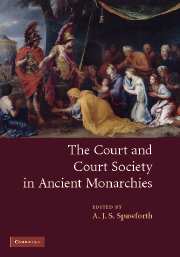Book contents
- Frontmatter
- Contents
- List of figures
- List of tables
- Notes on contributors
- Acknowledgements
- List of abbreviations
- Introduction
- 1 New out of old? Court and court ceremonies in Achaemenid Persia
- 2 King, court and royal representation in the Sasanian empire
- 3 The court of Alexander the Great between Europe and Asia
- 4 Friends in high places: the creation of the court of the Roman emperor
- 5 The imperial court of the late Roman empire, C. AD 300–C. AD 450
- 6 The imperial court in Han China
- 7 Court and palace in ancient Egypt: the Amarna period and later Eighteenth Dynasty
- Bibliography
- Index
4 - Friends in high places: the creation of the court of the Roman emperor
Published online by Cambridge University Press: 22 September 2009
- Frontmatter
- Contents
- List of figures
- List of tables
- Notes on contributors
- Acknowledgements
- List of abbreviations
- Introduction
- 1 New out of old? Court and court ceremonies in Achaemenid Persia
- 2 King, court and royal representation in the Sasanian empire
- 3 The court of Alexander the Great between Europe and Asia
- 4 Friends in high places: the creation of the court of the Roman emperor
- 5 The imperial court of the late Roman empire, C. AD 300–C. AD 450
- 6 The imperial court in Han China
- 7 Court and palace in ancient Egypt: the Amarna period and later Eighteenth Dynasty
- Bibliography
- Index
Summary
Introduction
The end of the first century BC witnessed a profound transformation of the Roman res publica from a political system in which power was diffused across a range of democratic and aristocratic institutions to one where power was seen to reside primarily in the hands of one man. This period of change and experiment provides a unique opportunity to see a court and court society coming into being, a process of interest not just to Roman historians but also to all those who seek to understand the nature of court societies.
The first impetus for the creation of any court society is the recognition of the ruler as the monopoly, or near-monopoly, possessor of power. I would argue that all societies in which power becomes the monopoly of the ruler create the conditions for the emergence of some form of ‘court society’; in other words this is a truly sociological, or even anthropological, phenomenon. Norbert Elias’ famous study of court society (Elias 1983) starts by claiming a specifically sociological approach as opposed to a historical one; however, he ends up by representing his chosen court society, that of Louis XIV in France, as a stage in the formation of the modern state, which is in essence a historical argument. In claiming that the court is a sociological phenomenon I am not suggesting that all court societies develop in the same way or in accordance with some law of nature.
- Type
- Chapter
- Information
- The Court and Court Society in Ancient Monarchies , pp. 121 - 156Publisher: Cambridge University PressPrint publication year: 2007
- 4
- Cited by



